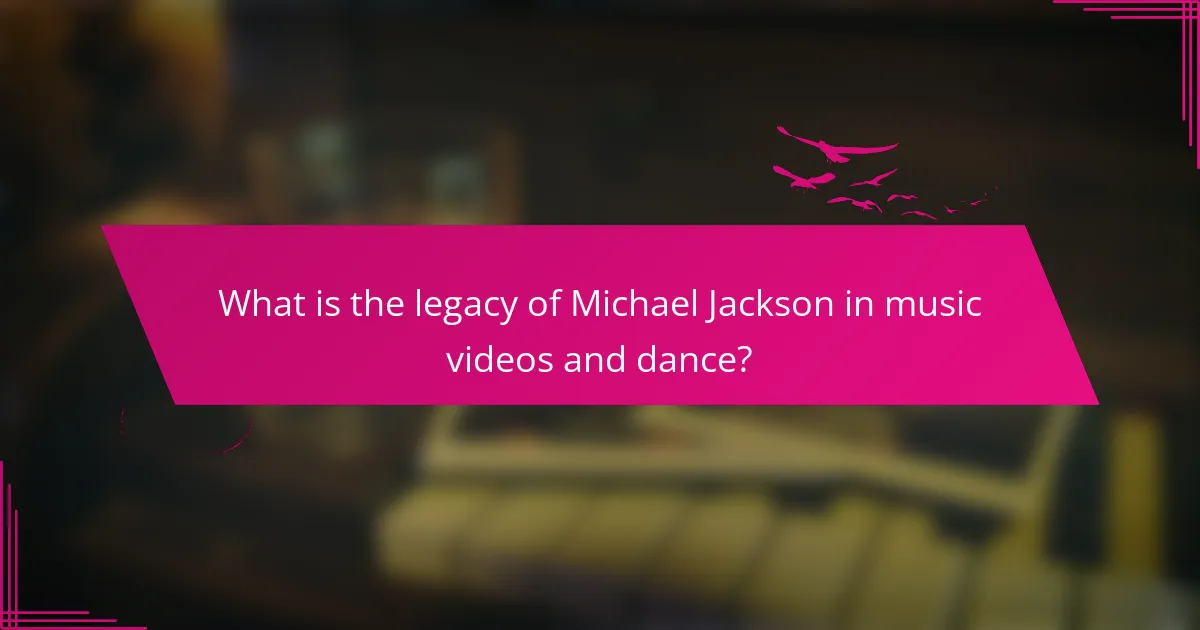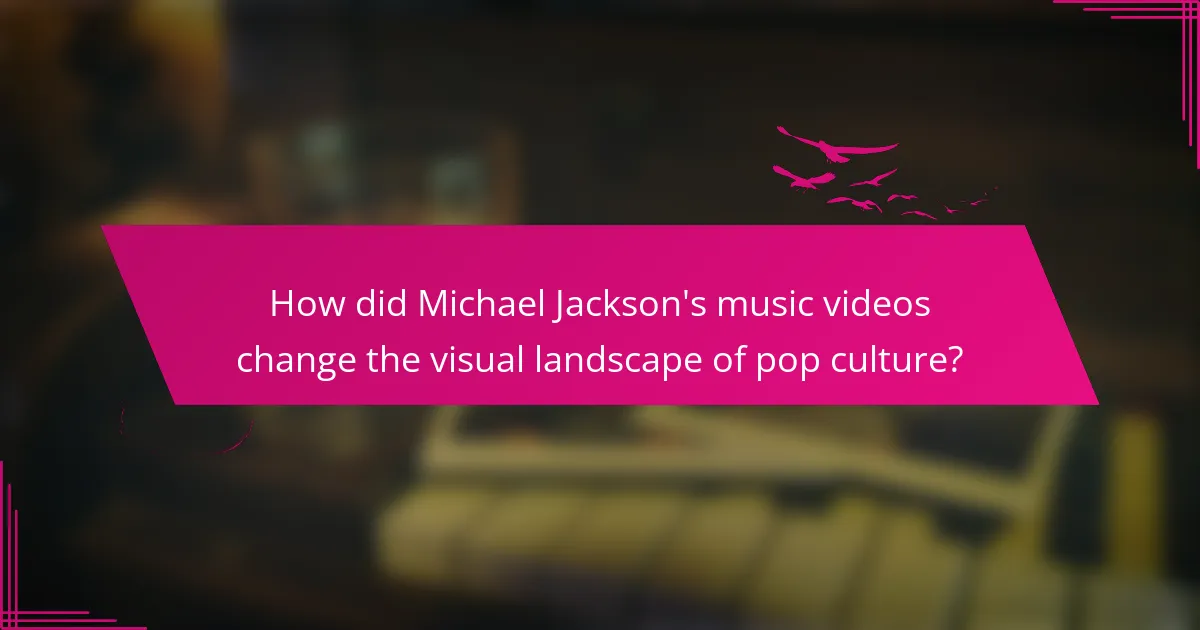Michael Jackson’s legacy in music videos and dance is characterized by his revolutionary contributions that transformed the visual landscape of pop culture. His iconic music video “Thriller,” released in 1983, set new standards with its narrative structure, high production values, and groundbreaking choreography. Jackson popularized dance moves like the moonwalk and collaborated with renowned directors, elevating the artistic quality of music videos. His innovative use of special effects and intricate performances influenced contemporary artists and established music videos as essential tools for creative expression and storytelling. Jackson’s impact remains evident in the visual style of modern music videos across various genres.

What is the legacy of Michael Jackson in music videos and dance?
Michael Jackson’s legacy in music videos and dance is profound and transformative. He revolutionized the music video format, turning it into an art form. His video for “Thriller” is often regarded as the greatest music video of all time. It featured a cinematic approach, storytelling, and intricate choreography. Jackson’s innovative use of special effects set new standards in the industry.
He popularized dance moves such as the moonwalk, which became iconic. His performances combined elements of theater, dance, and music in a unique way. Jackson’s influence is evident in the work of contemporary artists who cite him as an inspiration. Major awards, including MTV Video Music Awards, recognized his contributions. His impact on music videos and dance continues to be felt today.
How did Michael Jackson revolutionize music videos?
Michael Jackson revolutionized music videos by transforming them into an art form. He introduced elaborate storytelling and cinematic techniques in his videos. The video for “Thriller” is a prime example, featuring a narrative and choreography that captivated audiences. It was the first music video to be treated as a short film, running over 13 minutes. Jackson’s use of special effects and makeup set new standards in the industry. He also popularized dance sequences, making them integral to music videos. His performances influenced countless artists and reshaped viewer expectations. The impact of his work is still evident in today’s music video production.
What innovative techniques did he introduce in his music videos?
Michael Jackson introduced several innovative techniques in his music videos. He popularized narrative storytelling within music videos, transforming them into short films. His video for “Thriller” featured elaborate choreography and special effects, setting a new standard for production quality. Jackson also utilized groundbreaking makeup and costume design, particularly in “Thriller,” which showcased his transformation into a zombie. The integration of cinematic techniques, such as dramatic lighting and camera angles, enhanced the visual impact of his videos. Furthermore, he was one of the first artists to use music videos as a promotional tool, significantly increasing their importance in the music industry. His influence led to the establishment of music video awards, recognizing their artistic value. Jackson’s innovative approach has inspired countless artists and continues to shape the music video landscape today.
How did storytelling play a role in his music video productions?
Storytelling was central to Michael Jackson’s music video productions. His videos often featured narrative arcs that conveyed emotions and themes. For instance, “Thriller” showcased a horror narrative that captivated audiences. The use of characters and plots added depth to the music. This approach transformed music videos into cinematic experiences. Jackson’s storytelling techniques influenced the industry significantly. His work set a standard for blending music and visual art. This legacy continues to inspire artists today.
What impact did Michael Jackson’s dance style have on the music industry?
Michael Jackson’s dance style revolutionized the music industry. His signature moves, like the moonwalk, set new standards for performance. Artists began to incorporate intricate choreography into their music videos and live shows. This shift emphasized the importance of visual presentation in music. Jackson’s influence led to the rise of dance-centric pop stars in the 1980s and 1990s. His performances inspired choreographers and dancers globally. Music videos evolved into a platform for showcasing dance. Jackson’s impact remains evident in contemporary pop and hip-hop performances today.
What are the signature dance moves associated with Michael Jackson?
Michael Jackson is known for several signature dance moves. The Moonwalk is perhaps his most famous move, showcasing his unique ability to glide backward while appearing to walk forward. Another iconic move is the Anti-Gravity Lean, which gives the illusion of defying gravity. Jackson’s Spin, characterized by a fast, smooth rotation, is also widely recognized. The Robot, a mechanical style of dance, highlights his innovative approach to movement. The Thriller Dance, from his legendary music video, features a combination of choreography that has become synonymous with his legacy. Each of these moves has contributed to his status as a cultural icon and influenced countless dancers worldwide.
How did his dance influence other artists and genres?
Michael Jackson’s dance significantly influenced other artists and genres. His iconic moves, such as the moonwalk, became a global sensation. Artists like Usher and Beyoncé have cited him as an inspiration. His style blended various genres, including pop, rock, and hip-hop. This fusion encouraged artists to experiment with dance in their performances. The choreography in his music videos set new standards for visual storytelling in music. His influence extended to live performances, where elaborate dance routines became a norm. Jackson’s work has been studied in dance academies, highlighting his impact on contemporary dance. His legacy continues to inspire new generations of performers.

How did Michael Jackson’s music videos change the visual landscape of pop culture?
Michael Jackson’s music videos revolutionized the visual landscape of pop culture by integrating storytelling, elaborate choreography, and cinematic techniques. His video for “Thriller,” released in 1983, is often credited with setting a new standard for music videos. It featured a narrative structure and high production values, which were unprecedented at the time.
The groundbreaking use of special effects and makeup in “Thriller” transformed the way artists approached video production. Jackson’s performances in videos like “Beat It” and “Billie Jean” showcased intricate dance routines that influenced future artists.
His collaborations with renowned directors, such as Martin Scorsese and John Landis, elevated the artistic quality of music videos. These innovations made music videos a crucial part of an artist’s marketing strategy.
As a result, Jackson’s influence can be seen in the visual style of contemporary music videos across various genres. His work paved the way for artists to use music videos as a platform for creative expression and storytelling.
What themes and messages are prevalent in his music videos?
Michael Jackson’s music videos often explore themes of love, social justice, and self-expression. His iconic video “Thriller” delves into fear and transformation, showcasing the struggle between good and evil. In “Black or White,” he addresses racial harmony and unity, promoting the message of equality. The video for “Heal the World” emphasizes humanitarianism and caring for others, urging viewers to make a positive impact. Additionally, “Billie Jean” examines themes of fame and personal responsibility, highlighting the consequences of public scrutiny. Overall, Jackson’s music videos convey powerful messages that resonate with universal human experiences.
How did Michael Jackson address social issues through his music videos?
Michael Jackson addressed social issues through his music videos by incorporating powerful imagery and storytelling. His video for “Black or White” tackled racial harmony and unity. It featured diverse groups of people coming together, promoting acceptance. In “They Don’t Care About Us,” he highlighted human rights abuses and social injustices. The video showcased marginalized communities and their struggles. Jackson’s “Earth Song” focused on environmental issues and animal rights. It depicted the devastation caused by war and deforestation. His music videos often included strong visual narratives that raised awareness. Jackson used his platform to encourage dialogue about critical social issues.
What role did collaboration with directors play in his video success?
Collaboration with directors was crucial to Michael Jackson’s video success. Directors brought unique visions that elevated the storytelling in his music videos. For instance, the partnership with John Landis for “Thriller” resulted in a groundbreaking narrative structure. This collaboration combined cinematic techniques with music, creating a lasting impact. The innovative choreography and special effects set new standards in the industry. Additionally, working with directors like Martin Scorsese and Spike Lee expanded his creative range. Their combined expertise helped create iconic visuals that resonated with audiences. Overall, these collaborations significantly contributed to his legacy in music videos and dance.
How did Michael Jackson’s performances integrate music and dance?
Michael Jackson’s performances integrated music and dance through synchronized choreography and rhythmic movements. His signature dance moves, like the Moonwalk, complemented his musical beats. The choreography was meticulously crafted to enhance the storytelling in his songs. Jackson often collaborated with renowned choreographers such as Jeffrey Daniel and Michael Peters. His performances featured elaborate routines that captivated audiences globally. The combination of music and dance created a dynamic visual experience. Jackson’s use of innovative staging and lighting further emphasized this integration. His impact on live performances set a new standard in the entertainment industry.
What were the key elements of his live performances that showcased his dance innovations?
The key elements of Michael Jackson’s live performances that showcased his dance innovations included intricate choreography, signature moves, and visual storytelling. His performances featured complex routines that combined various dance styles, including pop, locking, and breakdancing. Jackson’s iconic moonwalk became a symbol of his unique style and was widely imitated. He often utilized props, such as hats and gloves, to enhance his movements. His use of stage effects, like smoke and lighting, created a dramatic atmosphere that complemented his dance. Collaborations with renowned choreographers, like Jeffrey Daniel, further refined his techniques. Jackson’s performances also emphasized synchronization with backup dancers, showcasing teamwork and precision. These elements collectively highlighted his groundbreaking approach to live dance performances.
How did technology enhance his music and dance presentations?
Technology enhanced Michael Jackson’s music and dance presentations through innovative audio-visual effects and advanced production techniques. The use of synthesizers and digital recording allowed for richer soundscapes in his music. High-definition video technology improved the visual quality of his performances. Jackson utilized motion capture technology to create groundbreaking dance sequences. This technology enabled the seamless blending of live performance with visual effects. The incorporation of sophisticated lighting systems added dramatic flair to his shows. Additionally, the use of video editing software allowed for creative storytelling in his music videos. These advancements set new standards for entertainment and influenced future artists.

What are some notable examples of Michael Jackson’s music videos and dance performances?
Notable examples of Michael Jackson’s music videos include “Thriller,” “Billie Jean,” and “Beat It.” “Thriller,” released in 1983, is renowned for its groundbreaking narrative and choreography. It features iconic dance sequences with zombies. “Billie Jean,” also from 1983, showcases Jackson’s famous moonwalk dance move. The video emphasizes his innovative use of light and shadow. “Beat It,” released the same year, combines rock and dance, featuring a memorable dance-off. Jackson’s performances, such as the Motown 25 performance of “Billie Jean,” introduced the moonwalk to a global audience. His live performances often included intricate choreography and visual storytelling, solidifying his status as a pioneer in music and dance.
Which music videos are considered his most groundbreaking?
Michael Jackson’s most groundbreaking music videos include “Thriller,” “Billie Jean,” and “Black or White.” “Thriller” revolutionized the music video format with its cinematic storytelling and elaborate choreography. It featured a 14-minute runtime and iconic dance sequences that set new standards for production quality. “Billie Jean” was notable for its innovative use of visual effects, particularly the light-up sidewalk. This video showcased Jackson’s signature dance moves, influencing countless artists. “Black or White” broke barriers with its themes of racial unity and featured groundbreaking morphing technology. Each of these videos had a significant impact on the music industry and pop culture, cementing Jackson’s legacy as a pioneer in music video artistry.
What innovations can be seen in the “Thriller” music video?
The “Thriller” music video introduced several groundbreaking innovations. It was one of the first music videos to feature a narrative storyline. The choreography integrated cinematic elements, making it feel like a short film. Special effects, such as makeup and animatronics, were used to create realistic zombies. The video also included a spoken-word segment by actor Vincent Price, adding a unique audio element. High production values set a new standard for music videos. The intricate dance sequences became iconic and influenced future artists. “Thriller” also popularized the concept of music videos as a promotional tool for albums.
How did “Billie Jean” set new standards for music video production?
“Billie Jean” set new standards for music video production through its groundbreaking storytelling and visual effects. The video featured a narrative that complemented the song’s themes of fame and accusation. It introduced innovative choreography, prominently showcasing Michael Jackson’s iconic moonwalk. The use of lighting and special effects created a visually striking experience. This video was one of the first to receive heavy rotation on MTV, breaking racial barriers in music video programming. It elevated the music video format to an art form, influencing countless artists and directors. “Billie Jean” also demonstrated the potential for music videos to drive album sales and chart success. The production quality and artistic vision set a benchmark for future music videos.
What can current artists learn from Michael Jackson’s approach to music videos and dance?
Current artists can learn the importance of storytelling and visual impact from Michael Jackson’s approach to music videos and dance. His videos often conveyed a narrative, enhancing the emotional connection to the music. For example, “Thriller” combined horror elements with dance, creating a memorable experience. Jackson’s choreography was innovative, blending various styles to create unique movements. His signature moves, like the moonwalk, became iconic and defined his brand. Artists can also learn the value of high production quality. Jackson invested in elaborate sets, costumes, and special effects, which elevated his music videos. Collaboration with talented directors and choreographers was key to his success. His ability to engage audiences through both music and visuals set a standard in the industry.
What best practices can be applied to modern music video production?
Best practices for modern music video production include thorough pre-production planning. This involves developing a clear concept and storyboard. Collaborating with a skilled team enhances creativity and execution. Utilizing high-quality equipment ensures professional visuals and sound. Incorporating innovative technology, such as drones or CGI, can elevate the production. Engaging with the audience through social media builds anticipation and expands reach. Lastly, analyzing viewer feedback post-release informs future projects. These practices lead to impactful and memorable music videos.
How can artists incorporate innovative dance elements into their performances?
Artists can incorporate innovative dance elements into their performances by blending various dance styles. This fusion creates a unique visual experience. For example, integrating hip-hop with ballet can showcase versatility. Utilizing technology, such as projection mapping, enhances the choreography. Incorporating props, like LED lights, adds visual interest. Collaborating with other artists encourages fresh ideas. Studying influential dancers, like Michael Jackson, inspires creativity. His signature moves, such as the moonwalk, revolutionized performance styles. These strategies enhance overall artistic expression and audience engagement.
Michael Jackson is the central entity of this article, which explores his profound legacy in music videos and dance. The article outlines how Jackson revolutionized the music video format, particularly through his iconic work “Thriller,” which set new standards for storytelling, choreography, and special effects. It details his innovative dance moves, such as the moonwalk, and their impact on the music industry, inspiring countless contemporary artists. Additionally, the article examines the thematic depth of Jackson’s videos, his collaborations with directors, and the lasting influence of his artistic approach on modern music and dance performances.